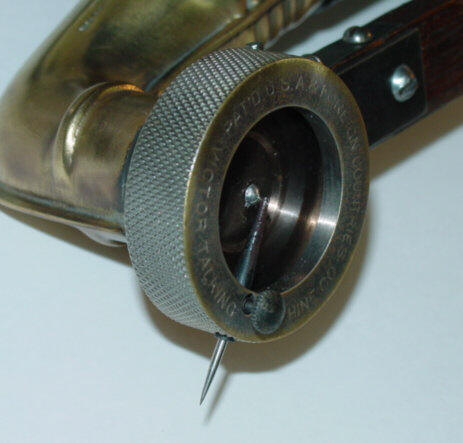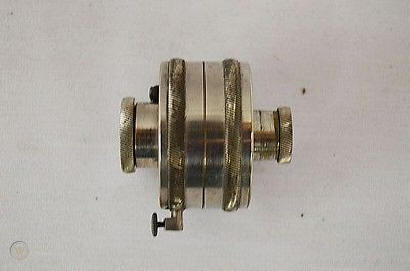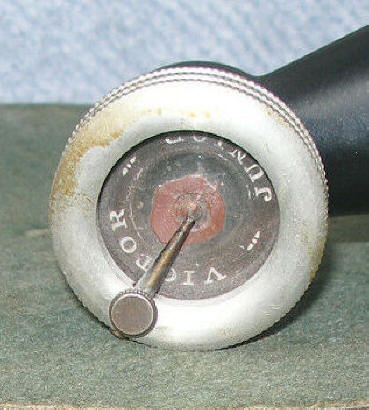
The Victor-Victrola Page

Design Details:
1. Horns
4. Soundboxes
Pictures and details on some of the design features of External Horn Victor phonographs. Each sequential page covers one aspect of the evolving designs. Advance to the next page via the link above or at the bottom of each page.
Important Note: Soundboxes for external-horn Victors were sold in either nickel plate or gold finishes. Soundboxes are often referred to as "reproducers" by some collectors, but this term was not used by Victor Talking Machine Company.
It was common for customers to purchase newer soundboxes for use on older model phonographs, as the later designs had improved sound reproduction. This "updating" of soundboxes was encouraged by Victor dealers as well. Consequently, it is common to find an early Victor with a later-vintage soundbox installed.
New
Century. The
earliest Victor phonographs used a soundbox called the "New Century".
It was used on a very limited number of the earliest production machines, and are
not often found today. Designed by inventor Robert Gibson, it was manufactured
in partnership with Eldridge Johnson, the founder of The Victor Talking Machine
Company.
 Concert.
The most common soundbox found on early Victor machines is the "Concert" model.
These soundboxes were used on machines up
until 1904-1905, when the "Exhibition" model was
introduced. Concert soundboxes can be readily spotted by the relatively long
"throat" (horn attachment point)
Concert.
The most common soundbox found on early Victor machines is the "Concert" model.
These soundboxes were used on machines up
until 1904-1905, when the "Exhibition" model was
introduced. Concert soundboxes can be readily spotted by the relatively long
"throat" (horn attachment point)
No. 10 Soundbox. Some early "Victor VI" models could be purchased with this exclusive and optional soundbox, which is extremely rare today (no picture available).
 No.
15 Soundbox (Auxetophone). The Victor "Auxetophone"
model utilized a special soundbox which allowed compressed air (from an external
system) to be fed into the soundbox, providing a significant amplification in
sound volume. These are quite rare, and highly prized today.
No.
15 Soundbox (Auxetophone). The Victor "Auxetophone"
model utilized a special soundbox which allowed compressed air (from an external
system) to be fed into the soundbox, providing a significant amplification in
sound volume. These are quite rare, and highly prized today.
Exhibition.
Victor introduced the famous "Exhibition" soundbox
at the end of 1904,
which was a vast improvement in sound reproduction from the earlier "Concert"
version. This was the standard soundbox on Victors and Victrolas for many years.
The Exhibition was used across many different models through 1925, at which time
they were installed only on phonographs intended for export.
 Victor
Jr. A special soundbox was used for the "Victor Jr." models, which
were low-cost machines intended for use by children. Like the No. 15 (above)
it had a shrouded body to protect the mica diapraghm from being damaged by
small fingers.
Victor
Jr. A special soundbox was used for the "Victor Jr." models, which
were low-cost machines intended for use by children. Like the No. 15 (above)
it had a shrouded body to protect the mica diapraghm from being damaged by
small fingers.
No. 2
This soundbox was first introduced on the internal horn Victrolas in 1917, and
was provided on a very limited number of late Victors (after 1920); however,
most Victor models
continued to use the Exhibition soundbox until 1925. Of
course, any owner could upgrade their older Victor with this soundbox at any
dealer if they so desired. This model produces a
greater overall volume than the earlier soundboxes.
No 15
(Second version). Victor provided a different "No. 15" soundbox in the summer of 1908
which was included with the
low-cost "Victor O" models up until 1922. It is essentially an Exhibition soundbox
with a metal "shrouded" body which covers part of the mica diaphragm. This may
have been done to protect the diaphragm from damage when used by children. In late 1911, the
No. 15 was used for a few
months on the early "Victrola IV" models, but by January, 1912, all Victrola IV
models used the standard Exhibition soundbox.

